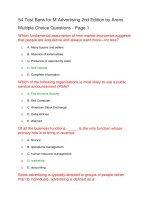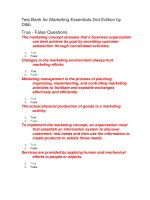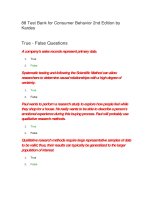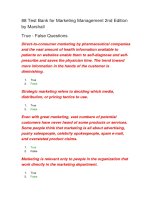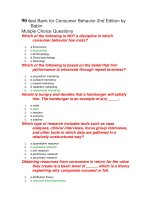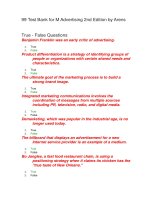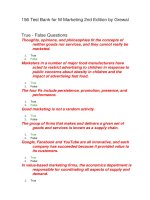Download test bank for organic chemistry 2nd edition by klein
Bạn đang xem bản rút gọn của tài liệu. Xem và tải ngay bản đầy đủ của tài liệu tại đây (212.41 KB, 29 trang )
Test Bank for Organic Chemistry 2nd Edition by Klein
Link download full: />Chapter Fourteen
Topic: Introduction to Ethers
Section: 14.1
1. Which of the following compounds is(are) classified as ethers?
A) I
B) II & IV
C) III
D) I & III
E) all of these Ans: E
Topic: Nomenclature of Ethers
Section: 14.2
Difficulty Level: Easy
2. What is the common name for CH3CH2CH2OCH2CH2CH3?
A) Dibutylether
B) 1-propoxypropane
C) 1-propoxyhexane
D) dipropyl ether
E) none of these Ans: D
Topic: Nomenclature of Ethers
Section: 14.2
Difficulty Level: Easy
3. What is the common name for (CH3)2CHCH2OCH(CH3)2?
A) Diisobutylether
B) isobutyl isopropyl ether
C) sec-butyl isopropyl ether
D) Diisopropylether
E) none of these
Ans: B
Topic: Nomenclature of Ethers
Section: 14.2
Difficulty Level: Easy
4. What is the IUPAC name for CH3CH2CH2CH2OCH2CH3?
A) 1-ethoxybutane
B) 1-butoxyethane
C) ethyl butyl ether
D) 1-ethoxyhexane
E) none of these Ans: A
Topic: Nomenclature of Ethers
Section: 14.2
Difficulty Level: Medium
5. What is the common name for the following compound?
A) 1-butoxybutane
B) sec-butyl isopropyl ether
C) sec-butyl t-butyl ether
D) n-butyl isopropyl ether
E) none of these Ans: C
Topic: Nomenclature
Section: 14.2
Difficulty Level: Medium
6. What is the IUPAC name for CH3CH2OCH2CH2CH2CH2OCH2CH3?
A) 1,4-ethoxyoctane
B) diethoxy butyl ether
C) 1,2-diethoxymethane
D) 1,2-diethoxyhexane
E) 1,4-diethoxybutane Ans: E
Topic: Nomenclature
Section: 14.2
Difficulty Level: Medium
7. What is the correct structure for benzyl phenyl ether?
A) I
B) II
C) III
D) IV
E) none of these
Ans: D
Topic: Nomenclature
Section: 14.2
Difficulty Level: Medium
8. What is the correct structure for dibenzyl ether?
A) I
B) II
C) III
D) IV
E) none of these
Ans: B
Topic: Nomenclature
Section: 14.2
Difficulty Level: Medium
9. What is the IUPAC name for the following compound?
Ans: 3-isopropoxy-2-methyloctane
Topic: Nomenclature
Section: 14.2
Difficulty Level: Medium
10. What is the IUPAC name for the following compound?
Ans: 1-ethoxy-1-methoxy-3-propylcyclohexane
Topic: Nomenclature
Section: 14.2
Difficulty Level: Medium
11. What is the IUPAC name for the following compound?
Ans: E-4-isopropoxy-4,5-dimethylhex-2-ene
Topic: Nomenclature
Section: 14.2
Difficulty Level: Medium
12. What is the IUPAC name for the following compound?
Ans: (1S,3S)-1-ethoxy-3-methylcyclohexane
Topic: Nomenclature
Section: 14.2
Difficulty Level: Hard
13. What is the IUPAC name for the following compound?
Ans: 1,1,1-triethoxyethane
Topic: Nomenclature
Section: 14.2
Difficulty Level: Hard
14. Provide the structure for 2-iodo-4-isopropyl-1-methoxybenzene. Ans:
Topic: Nomenclature
Section: 14.2
Difficulty Level: Hard
15. Provide an IUPAC name for the following compound.
Ans: 4-t-butyl-1-ethoxy-2-methylbenzene
Topic: Nomenclature
Section: 14.2
Difficulty Level: Hard
16. Provide the structure for (2S,5R)-5-ethoxy-2-octanol. Ans:
Topic: Nomenclature
Section: 14.2
Difficulty Level: Hard
17. Provide the structure for (R)-1,1-dimethoxy-3-phenoxycyclopentane. Ans:
Topic: Nomenclature
Section: 14.2
Difficulty Level: Easy
18. Draw all constitutional isomers with molecular formula C4H8O having an ether
functional group and provide the IUPAC name for each isomer. Ans:
Topic: Nomenclature
Section: 14.2
Difficulty Level: Medium
19. Draw all constitutional isomers with molecular formula C6H14O having an ether
functional group and provide the IUPAC name for each isomer Ans:
Topic: Physical Properties
Section: 14.3
Difficulty Level: Easy
20. Which one of the following compounds will have the highest boiling point?
A) CH3CH2CH2CH2CH3
B) CH3CH2CH2CH2OH
C) CH3CH2CH2OCH3 D) CH3CH2CH2Cl
E) CH3CH2OCH2CH3
Ans: B
Topic: Physical Properties
Section: 14.3
Difficulty Level: Easy
21. Which one of the following compounds will have the highest boiling point?
A) CH3CH2CH2CH2CH3
B) CH3CH2CH2CH2OH
C) CH3CH2CH2OCH3
D) CH3CH2CH2Cl
E) CH3CH2OCH2CHOH
Ans: E
Topic: Physical Properties
Section: 14.3
Difficulty Level: Easy
22. Which one of the following compounds will be least soluble in water?
A) diethyl ether
B) methyl propyl ether
C) 1-butanol
D) 2-butanol
E) pentane Ans: E
Topic: Physical Properties
Section: 14.3
Difficulty Level: Medium
23. Rank the following compounds in decreasing order of boiling points (highest to
lowest)
A) II>IV>I>III
B) I>IV>II>III
C) IV>I>II>III
D) III>II>I>IV
E) IV>II>I>III Ans: C
Topic: Physical Properties
Section: 14.3
Difficulty Level: Medium
24. Rank the following compounds in decreasing order of water solubility (highest
to lowest)
A) II>IV>I>III
B) I>IV>II>III
C) IV>I>II>III
D) III>II>I>IV
E) IV>III>I>II Ans: E
Topic: Physical Properties
Section: 14.3
Difficulty Level: Medium
25. Which one of the following compounds has highest boiling point?
Ans: III
Topic: Crown ethers
Section: 14.4
Difficulty Level: Medium
26. What is the IUPAC name for the following compound?
A) 15-crown-5
B) 15-crown-4
C) 5-crown-15
D) 15-crown-15
E) none of these Ans: A
Topic: Crown ethers
Section: 14.4
Difficulty Level: Medium
27. What is the correct IUPAC name for the following compound?
A) 12-crown-5
B) 12-crown-4
C) 4-crown-12
D) 12-crown-12
E) none of these Ans: B
Topic: Crown ethers
Section: 14.4
Difficulty Level: Easy
28. Which of the following crown ether solvates lithium ions?
A) 12-crown-5
B) 12-crown-4
C) 15-crown-5
D) 18-crown-6
E) none of these Ans: B
Topic: Crown ethers
Section: 14.4
Difficulty Level: Easy
29. Which of the following crown ether solvates potassium ions?
A) 12-crown-5
B) 12-crown-4
C) 15-crown-5
D) 18-crown-6
E) none of these Ans: D
Topic: Crown ethers
Section: 14.4
Difficulty Level: Easy
30. Which of the following crown ether solvates sodium ions?
A) 12-crown-5
B) 12-crown-4
C) 15-crown-5
D) 18-crown-6
E) none of these Ans: C
Topic: Crown ethers
Section: 14.4
Difficulty Level: Medium
31. Identify the missing reagent needed to carry out the following transformation.
A) 12-crown-5
B) 12-crown-4
C) 15-crown-5
D) 18-crown-6
E) none of these Ans: C
Topic: Crown ethers
Section: 14.4
Difficulty Level: Medium
32. Identify the missing reagent needed to carry out the following transformation.
A) 12-crown-5
B) 12-crown-4
C) 15-crown-5
D) 18-crown-6
E) none of these
Ans: B
Topic: Crown ethers
Section: 14.4
Difficulty Level: Hard
33. Identify the missing reagent needed to carry out the following transformation.
Ans: 18-crown-6
Topic: Crown ethers
Section: 14.4
Difficulty Level: Hard
34. Identify the missing reagent needed to carry out the following transformation.
Ans: 18-crown-6
Topic: Preparation of ethers
Section: 14.5
Difficulty Level: Easy
35. Predict the product for the following reaction.
A) Propene
B) Diethyl ether
C) 1-hexanol
D) 1-propoxypropane Ans: D
Topic: Preparation of ethers
Section: 14.5
Difficulty Level: Medium
36. Predict the product for the following reaction.
Ans:
Topic: Preparation of Ethers
Section: 14.5
Difficulty Level: Hard
37. Provide a curved arrow mechanism for the formation of the product.
Ans:
Topic: Preparation of ethers
Section: 14.5
Difficulty Level: Medium
38.Can you prepare diisopropyl ether as major product by heating 2-propanol in
the presence of sulfuric acid? Explain your answer.
Ans: No. Secondary and tertiary alcohols undergo elimination reactions when
heated in the presence of a strong acid, such as sulfuric acid. The major product is
an alkene and not an ether. 2-propanol is a secondary alcohol and it will yield
propene as the major product.
Topic: Preparation of ethers
Section: 14.5
Difficulty Level: Medium
39. Which one of the following reactions would produce t-butyl methyl ether in high
yield?
A) t-butyl chloride + sodium methoxide
B) t-butanol + methanol in presence of H2SO4 at 140 C
C) t-butyl bromide + bromomethane in presence of NaOH
D) sodium t-butoxide + bromomethane Ans: D
Topic: Preparation of ethers
Section: 14.5
Difficulty Level: Medium
40. Which one of the following reactions would produce t-butyl methyl ether in
high yield?
A) CH3ONa + (CH3)3CBr
B) CH3OH + (CH3)3COH in presence of H2SO4 at 140
C
C) CH3Cl + (CH3)3CBr in presence of NaOH
D) (CH3)3CONa + CH3Br Ans: D
Topic: Preparation of ethers
Section: 14.5
Difficulty Level: Medium
41. Which one of the following reactions would produce (S)-3-methoxyheptane in
high yield?
A) sodium (S)-3-heptoxide + bromomethane
B) sodium (R)-3-heptoxide + bromomethane
C) sodium methoxide + (S)-3-bromoheptane
D) sodium methoxide + (R)-3-bromoheptane Ans: A
Topic: Preparation of ethers
Section: 14.5
Difficulty Level: Medium
42. Predict the product for the following reaction.
Ans:
Topic: Preparation of ethers
Section: 14.5
Difficulty Level: Medium
43. Provide the reagents necessary to carry out the following conversion.
Ans: 1. PBr3
2.
Topic: Preparation of ethers
Section: 14.5
Difficulty Level: Hard
44.Predict the product for the following reaction.
Ans:
Topic: Preparation of ethers
Section: 14.5
Difficulty Level: Medium
45. Provide the reagents necessary to prepare the following compound using a
Williamson ether synthesis. Ans:
Topic: Preparation of ethers
Section: 14.5
Difficulty Level: Medium
46.Provide the reagents necessary to prepare the following compound using
Williamson ether synthesis. Ans:
Topic: Preparation of ethers
Section: 14.5
Difficulty Level: Hard
47. Predict the product for the following reaction and provide a curved arrow
mechanism for the formation of the product.
Ans:
Mechanism
Topic: Preparation of Ethers
Section: 14.5
Difficulty Level: Medium
48. Predict the product for the following reaction.
A) 3-methyl-3-pentanol
B) 3-ethoxy-3-methylpentane
C) 3-methyl-2-pentanol
D) 2-ethoxy-3-methylpentane
E) 1-ethoxy-3-methylpentane Ans: B
Topic: Preparation of Ethers
Section: 14.5
Difficulty Level: Hard
49.Predict the product for the following reaction.
A) 1-ethyl-1-cyclohexanol
B) 2-ethoxy-1-ethylcyclohexane
C) 1-ethoxy-1-ethylcyclohexane
D) 2-ethoxy-3-ethylcyclohexane
E) 1-ethoxy-2-ethylcyclohexane Ans: C
Topic: Preparation of Ethers
Section: 14.5
Difficulty Level: Hard
50.Predict the product for the following reaction.
A) 2-methyl-1-hexanol
B) 2-methoxy-2-methylhexane
C) 1-methoxy-2-methylhexane
D) 2-methoxy-3-methylhexane
E) 2-methyl-2-hexanol Ans: B
Topic: Preparation of Ethers
Section: 14.5
Difficulty Level: Hard
51. Predict the product for the following reaction.
Ans:
Topic: Preparation of Ethers
Section: 14.5
Difficulty Level: Hard
52. . Predict the product for the following reaction. Ans:
Topic: Preparation of Ethers
Section: 14.5
Difficulty Level: Hard
53. . Provide the reagents necessary to prepare the following compound using
alkoxymercuration-demercuration.
Ans:
OR
OR
Topic: Preparation of Ethers
Section: 14.5
Difficulty Level: Hard
54. . Provide the reagents necessary to carry out the following conversion. Ans:
Topic: Reactions of Ethers
Section: 14.6
Difficulty Level: Easy
55. Predict the product(s) for the following reaction.
A) ethanol + 1-bromopropane B)
1-propanol + bromoethane
C) 1-propanol + ethanol
D) 1-bromopropane + bromoethane
E) none of these Ans: D
Topic: Reactions of Ethers
Section: 14.6
Difficulty Level: Easy
56. Predict the product(s) for the following reaction.
A) ethanol + phenol
B) phenol + iodoethane
C) iodobenzene + ethanol
D) iodobenzene + iodoethane
E) none of these Ans: B
Topic: Reactions of Ethers
Section: 14.6
Difficulty Level: Medium
57. Predict the product(s) for the following reaction.
A) I
B) II
C) III
D) IV
E) V
Ans: C
Topic: Reactions of Ethers
Section: 14.6
Difficulty Level: Medium
58. Predict the product(s) for the following reaction.
A) I
B) II
C) III
D) IV
E) V
Ans: B
Topic: Reactions of Ethers
Section: 14.6
Difficulty Level: Medium
59. Predict the product(s) for the following reaction and provide a curved arrow
mechanism for the formation of the product.
Ans:
Mechanism
Topic: Reactions of Ethers
Section: 14.6
Difficulty Level: Hard
60. Predict the product(s) for the following
reaction. Ans:
Topic: Reactions of Ethers
Section: 14.6
Difficulty Level: Hard
61. Predict the product(s) for the following reaction and provide a curved arrow
mechanism for the formation of the product.
Ans:
Mechanism
Topic: Reactions of Ethers
Section: 14.6
Difficulty Level: Hard
62. Predict the product(s) for the following reaction.
Ans:
Topic: Reactions of Ethers
Section: 14.6
Difficulty Level: Medium
63. Predict the product(s) for the following reaction.
Ans:
Topic: Reactions of Ethers
Section: 14.6
Difficulty Level: Medium
64. Explain why long-term storage of ethers can be dangerous.
Ans: Ethers undergo autooxidation in the presence of atmospheric oxygen via a
radical mechanism to form hydroperoxides. These hydroperoxides are unstable and
can explode on heating.
Topic: Nomenclature of epoxides
Section: 14.7
Difficulty Level: Easy
65. What is the IUPAC name for the following compound?
A) 3-ethyl-2-methyloxirane
B) 2-ethyl-3-methyloxirane
C) 2-ethyl-1-methyloxypentane
D) 1-ethyl-2-methyloxypentane
E) none of these Ans: B
Topic: Nomenclature of epoxides
Section: 14.7
Difficulty Level: Medium
66.What is the IUPAC name for the following compound?
A) 2-ethyl-3-isopropyl-2-methyloxirane
B) 1-ethyl-2-isopropyl-1-methyloxirane
C) 2,4-dimethyloxyhexane
D) 1-ethyl-2,4-dimethyloxyhexane
E) 3-ethyl-2-isopropyl-3-methyloxirane Ans: A
Topic: Nomenclature of epoxides
Section: 14.7
Difficulty Level: Medium
67. Provide the structure for tetrahydrofuran. Ans:
Topic: Nomenclature of epoxides
Section: 14.7
Difficulty Level: Medium
68. Provide the structure for oxetane.
Ans: Topic: Nomenclature of epoxides
Section: 14.7
Difficulty Level: Medium
69.Provide the IUPAC name for the following compound.
Ans: (2S, 3S)-2-ethyl-3-isopropyloxirane
Topic: Nomenclature of epoxides
Section: 14.7
Difficulty Level: Medium
70. Provide the IUPAC name for the following compound.
Ans: (2S, 3R)-2-ethyl-3-phenyloxirane
Topic: Nomenclature of epoxides
Section: 14.7
Difficulty Level: Medium
71. Provide the common name for the following compound.
Ans: 1,4-dioxane
Topic: Nomenclature of epoxides
Section: 14.7
Difficulty Level: Medium
72. Provide the IUPAC name for the following compound.
Ans: (1S,2R)-1-methyl-1,2-epoxycyclohexane
Topic: Nomenclature of epoxides
Section: 14.7
Difficulty Level: Medium
73. Provide the structure for (1S,2R)-1-ethyl-2-methyl-1,2-epoxycyclohexane. Ans:
Topic: Nomenclature of epoxides
Section: 14.7
Difficulty Level: Medium
74. Provide the structure for (R)-2,2,3-trimethyl-3-phenyloxirane. Ans:
Topic: Preparation of epoxides
Section: 14.8
Difficulty Level: Medium
75. Predict the product for the following reaction. (E)-2-pentene + mCPBA
A) I
B) II
C) III
D) IV
Ans: D
Topic: Preparation of epoxides
Section: 14.8
Difficulty Level: Medium
76. Predict the product for the following reaction. (Z)-3-hexene
+ mCPBA
A) I
B) II
C) III
D) IV
Ans: A
Topic: Preparation of epoxides
Section: 14.8
Difficulty Level: Medium
77. Predict the product for the following reaction.
A) I
B) II
C) III
D) IV
Ans: C
Topic: Preparation of epoxides
Section: 14.8
Difficulty Level: Medium
78. Predict the product for the following reaction.
1-methylcyclohexene + mCPBA Ans:
Topic: Preparation of epoxides
Section: 14.8
Difficulty Level: Medium
79. Provide the reagents necessary to carry out the following conversion.
Ans: mCPBA
Topic: Preparation of epoxides
Section: 14.8
Difficulty Level: Medium
80. Predict the product for the following reaction.
A) I
B) II
C) III
D) IV
Ans: D
Topic: Preparation of epoxides
Section: 14.8
Difficulty Level: Medium
81. Predict the product for the following reaction.
Ans:
Topic: Preparation of epoxides
Section: 14.8
Difficulty Level: Medium
82. Provide the structure(s) of the product(s) in the following reaction
sequence. Ans:
Topic: Preparation of epoxides
Section: 14.8
Difficulty Level: Medium
83.Predict the product for the following reaction.
Ans:
Topic: Preparation of epoxides
Section: 14.8
Difficulty Level: Medium
84. Provide the reactants necessary to prepare the following
compound. Ans:
Topic: Preparation of epoxides
Section: 14.8
Difficulty Level: Medium
85. Provide the reactants necessary to prepare the following compound.
Ans:
Topic: Preparation of epoxides
Section: 14.8
Difficulty Level: Medium
86. Provide the reactants necessary to prepare the following
compound. Ans:
Topic: Preparation of epoxides
Section: 14.9
Difficulty Level: Medium
87. Predict the product for the following reaction.
Ans:
Topic: Preparation of epoxides
Section: 14.9
Difficulty Level: Medium
88. Predict the product for the following
reaction. Ans:
Topic: Preparation of epoxides
Section: 14.9
Difficulty Level: Medium
89. Predict the product for the following
reaction. Ans:
Topic: Preparation of epoxides
Section: 14.9
Difficulty Level: Medium
90. Predict the product for the following
reaction. Ans:
Topic: Reactions of epoxides
Section: 14.10
Difficulty Level: Easy
91. Predict the product(s) for the following reaction.
A) I
B) II
C) III
D) IV
E) none of these Ans: C
Topic: Reactions of epoxides
Section: 14.10
Difficulty Level: Easy
92. Predict the product(s) for the following reaction.
A) I
B) II
C) III
D) IV
E) none of these Ans: A
Topic: Reactions of epoxides
Section: 14.10
Difficulty Level: Easy
93. Predict the product(s) for the following reaction.
A) I
B) II
C) III
D) IV
E) none of these Ans: B
Topic: Reactions of epoxides
Section: 14.10
Difficulty Level: Medium
94. Predict the product(s) for the following reaction.
A) I
B) II
C) III
D) IV
E) none of these Ans: A
Topic: Reactions of epoxides
Section: 14.10
Difficulty Level: Medium
95. Predict the product(s) for the following reaction.
A) I
B) II
C) III
D) IV
E) none of these
Ans: C
Topic: Reactions of epoxides
Section: 14.10
Difficulty Level: Medium
96.Provide the reagents necessary to carry out the following conversion.
Ans: HCl
Topic: Reactions of epoxides
Section: 14.10
Difficulty Level: Medium
97. Provide the reagents necessary to carry out the following conversion.
Ans: CH3OH/H2SO4
Topic: Reactions of epoxides
Section: 14.10
Difficulty Level: Medium
98. Predict the product(s) for the following reaction.
A) I
B) II
C) III
D) IV
E) none of these Ans: A
Topic: Reactions of epoxides
Section: 14.10
Difficulty Level: Easy
99.Predict the product(s) for the following reaction.
A) I
B) II
C) III
D) IV
E) none of these Ans: C
Topic: Reactions of epoxides
Section: 14.10
Difficulty Level: Easy
100.Predict the product(s) for the following reaction.
A) I
B) II
C) III
D) IV
E) none of these Ans: D
Topic: Reactions of epoxides
Section: 14.10
Difficulty Level: Medium
101. Predict the product(s) for the following reaction.
Ans:
Topic: Reactions of epoxides
Section: 14.10
Difficulty Level: Medium
102. Predict the product(s) for the following reaction.
Ans:
Topic: Reactions of epoxides
Section: 14.10
Difficulty Level: Medium
103. Provide the reagents necessary to carry out the following conversion.
Ans: 1. mCPBA
2. CH3MgBr
3. H2O
Topic: Reactions of epoxides
Section: 14.10
Difficulty Level: Hard
104. Provide the reagents necessary to carry out the following conversion.
Ans: 1. LiAlH4
2. H2O
Topic: Reactions of epoxides
Section: 14.10
Difficulty Level: Hard
105. Provide the reagents necessary to carry out the following conversion.
Ans: 1. mCPBA
2. NH3
Topic: Reactions of epoxides
Section: 14.10
Difficulty Level: Hard
106. Provide the reagents necessary to carry out the following conversion.
Ans: 1. 2.
H2O
Topic: Reactions of epoxides
Section: 14.10
Difficulty Level: Hard
107. Provide a stepwise curved arrow mechanism for the following reaction.
Ans:
Topic: Nomenclature of Thiols /sulfides
Section: 14.11
Difficulty Level: Easy
108. What is the correct structure for 3-methyl-1-hexanethiol?
Ans:
Topic: Nomenclature of Thiols /sulfides
Section: 14.11
Difficulty Level: Medium
109. What is the correct structure for phenylthiol?
Ans:
Topic: Nomenclature of Thiols /sulfides
Section: 14.11
Difficulty Level: Medium
110. What is the IUPAC name for the following compound?
Ans: 5-methyl-2-heptanethiol
Topic: Nomenclature of Thiols /sulfides
Section: 14.11
Difficulty Level: Hard
111. What is the IUPAC name for the following compound?
Ans: 5-mercapto-2-methyl-1-hexanol
Topic: Nomenclature of Thiols /sulfides
Section: 14.11
Difficulty Level: Medium
112. What is the common name for the following compound?
Ans: Methyl pentyl sulfide
Topic: Nomenclature of Thiols /sulfides
Section: 14.11
Difficulty Level: Medium
113. What is the IUPAC name for the following compound?
Ans: 2-ethylthiohexane
Topic: Preparation of Thiols /sulfides
Section: 14.11
Difficulty Level: Easy
114. Predict the product for the following reaction.
Ans:
Topic: Preparation of Thiols /sulfides
Section: 14.11
Difficulty Level: Medium
115. Predict the product for the following reaction.
